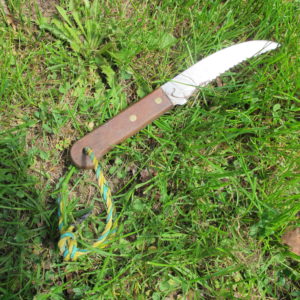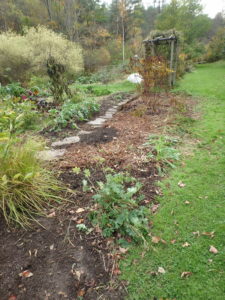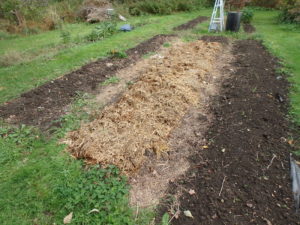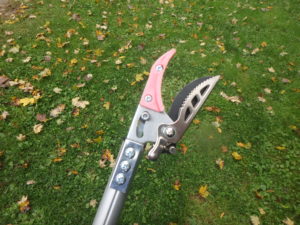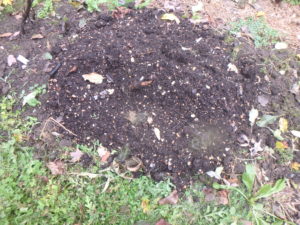Putting the Garden to Bed
Pardon me for saying so, but it’s time to get ready for winter. That’s right. A few days ago (or was it weeks?) we were swimming in the ocean and lounging in the sun. But we’ve had frost, and I’ve seen serious snow as early as October 15. Here are some of the things on my list:
Clean up the vegetable garden. Harvest the last of the root crops, pull the weeds and mulch everything with leaves. The key here is this: pull the weeds.
Annual weeds will die with the cold, of course, but most have produced seeds by now that will guarantee that their progeny will appear next year. When you pull them, try to avoid knocking loose the seeds. Be gentle.
Perennial weeds and grasses have serious roots that are hard to pull, and will survive the winter. If you can get them out now, you will have less work next spring. In the spring the soil will be wet, the air cold. We will still have some nice warm days for weeding before winter.
Use a good weeding tool to get all the roots out. I like the CobraHead weeder to tease out the roots and comb though the soil. It’s a simple hook that slides through the soil easily and lifts up scraps of root. You can suppress weeds in the spring by putting down old newspapers and covering them with straw or leaves.
Insect pests and fungal diseases can be minimized next year by getting rid of plants this fall. Tomatoes generally have at least some leaf blight, and squash family plants often have both insects and fungi by the end of the summer. Potato bugs may have visited your plants. So get rid of these plants by putting them in the household trash or by adding them to a pile of brush you will burn after snowfall. I suppose you could drag them off to a far corner of the property, but I know that potato bugs, at least, will hike a long way for a free lunch.
Clean up the flower garden. This entails cutting back most flowers and pulling weeds. I say cut back most flowers, but suggest leaving a few tall flowers for the birds – they like seeds of sunflowers, black-eyed Susans and purple coneflower, among others. Those tall plants also provide a little winter interest for you silhouetted against the snow.
Instead of cutting back your perennials with your pruners, try using a serrated knife. Next yard sale you see, stop and buy a steak knife. They work great. Grab a clump of stems and saw them off. I suppose one of those folding pruning saws would do it, too – but wear gloves and be careful using one. They are very sharp.
I’ve used hedge clippers, too, for fall cleanup, but often old clippers don’t do a good job on heavy stems; things get stuck between the blades. I have a pair that works well made by Barnel, their B1000L hedge shears. Available from www.oescoinc.com.
Should you rake the leaves out of your flower beds? That all depends. If you leave the leaves, they will help suppress weeds in the spring, and will eventually decompose. Still, many gardeners like the look of a clean flower bed. The choice is yours. Me? I generally leave them.
Another fall task involves improving the soil, particularly in the vegetable garden. Adding a layer of compost after weeding is always a good plan. Add an inch of more of compost and stir it in with a tool, and it will stimulate your soil to become more biologically active by adding and feeding soil microorganisms.
Many garden centers sell compost by the truckload for a price considerably more reasonable than by the bag. Dairy farms often sell aged manure or hot-composted manure (which is even better). Some will deliver it to your garden. If you keep your raised beds in place each year, just add the compost to the beds, don’t waste it on the walkways.
Fall is a great time to get your soil tested. Your state Extension Service offers this service, just go on-line and download the form. If you have never had soil tested, pay extra and get tested for heavy metals if you grow edibles. Houses built before 1978 (when lead was banned in paint) often have lead in the soil nearby – which is dangerous. A good soil test will not only tell you if your soil is deficient in minerals, it can tell you if it has adequate organic matter and a soil pH that works for your plants.
For a more in-depth soil test, you can do a test with Logan Labs (https://loganlabs.com/) and for a fee of $30, talk with a soil scientist about the results.
Last, rake the leaves, or better yet, chop them with the lawnmower and then rake them up. Chopped leaves are fantastic mulch, and a real boost to your soil. Earthworms love them, and will bring the organic matter down into the soil. When you cut the lawn at the end of the season, lower the blades a little because long grass is more susceptible to winter fungal problems.
There are plenty of other tasks to do in the garden, so play hooky on a sunny day and get back out into the garden. You’ll never regret doing so.
I now have pricing for the Viking River Cruise I hope to lead from Paris to Normandy and back next June 19 to 26. E-mail me for the details at henry.homeyer@comcast.net. This could be great fun, and I plan to do some gardening talks in the evenings.
Seven Fall Gardening Chores
For many years I was in denial. Yes, I refused to accept that fall and winter were on the way by October. I didn’t start fall clean up until November, and by then it was cold, raw, often wet and unpleasant out. Now, having reached a certain age, I prefer to work when it is warm and sunny – so I start fall clean up in September, and try hard to finish by the end of October. I recommend you do so, too. Here’s my list:
- Clean up the vegetable garden. This means pulling plants – and weeds – and covering the bare soil with mulch. I put things that might harbor disease or insect pests on my burn pile, everything else goes in the compost. So tomato and potato plants and all vine crops go on the burn pile.
As to mulching the soil, I do this for two reasons: First, I don’t want hard rains to wash away my topsoil. That is true everywhere on my property – bare soil invites erosion. Second, bare soil is open to receive wind-blown weed seeds. They would germinate next spring before I plant my tomatoes, if I let them.
What do I use for mulch? In the vegetable garden, I use fall leaves that I have chopped up with my lawnmower. They are great for improving the soil, too. I rarely have bare soil in my flower beds – they are full of perennials.
- Cut back perennials. Cleaning up the beds now, and doing a good weeding, will save me a lot of time in the spring – when I am busy with other spring tasks like planting my vegetables. I don’t cut back everything. I leave flowers with seeds that the finches and other seed-eaters will enjoy. Black-eyed Susans and purple coneflower are two they love. Sunflowers will get eaten in place, and most have already been eaten; if so, I cut down the stalks.
- Blackberries and raspberry plants need to be cut back now. Cut off the stems that produced berries this year and leave the new growth. These berries produce on second year growth.
I have a cut-and-grab pole pruner which helps me to avoid getting scraped by thorns. I just cut the plants at ground-level and the tool grabs on to the cut stem, allowing me to pull it out and place it in the wheelbarrow without getting bitten by the thorns. It is available from The Wildflower Seed & Tool Company (www.wildflower-seed.com or 800-456-3359). These tools come in various telescoping lengths.
- Add fuel stabilizer to your gas can now, so that your lawnmower and other power tools will go into winter with gas that will not go flat. Chain saws, rototillers and such need it too, and you may need to drain out the existing fuel, re-fill and run them for 10 minutes to avoid having gunky gas in the machines in spring. Ask at your local garage or auto part store.
After you have tended to your power tools, take a few minutes to clean up and oil your hand tools, too. Before you put away your shovels and rakes, wipe the metal clean of soil and apply a little light machine oil to prevent rusting. Wooden handles benefit from an application of boiled linseed oil. I have one tool with a wood handle that has been in my family for over 60 years. I don’t leave it outside in the rain, and I oil it once a year. It’s as good as new – and has a lovely patina.
- Divide daylilies, iris, phlox, asters and other large clumps of perennials now. Cut the stalks to the ground, and then lift the clump with a garden fork by going around the clump and loosening the soil on all sides. Then pry it out and divide into 2, 3 or 4 pieces with a shovel or a hand tool. Don’t worry about cutting the roots, they will not be damaged. You can do this in the spring if you prefer. This is also the time to move peonies, if you must.
- Feed your soil and lawn. Fall is a good time to add compost, fertilizer and limestone to your soil and lawn. I test my soil pH with a little kit that costs just about $5. I aim to have my soil pH between 6.2 and 6.8, which is just slightly acidic. If the pH in your soil is lower than 6.0, you should add limestone to raise the pH (except for blueberries, hollies and rhododendrons, which like acidic soil).
Adding compost will improve almost any soil. I added it to my vegetable garden for 30 years, and now have a soil so rich and black I need not add any more. Fertilizer? I only add organic fertilizers as they add all the micronutrients plants need, but that are not in chemical fertilizers. And organic fertilizers are slow-release.
- Lastly, mow your lawn before the snow flies. Bring the blades down lower, as a shorter cut will help to minimize risk of fungal diseases. Rake it if need be, so there are not clumps of grass left on the lawn.
Getting ready for winter is satisfying for me. It’s like tucking a child into bed. And I like looking out the windows and seeing a tidy garden, all ready for spring. Have at it!
Send comments or questions to Henry at henry.homeyer@comcast.net. Henry is a UNH lifetime Master Gardener, and the author of 4 gardening books.



